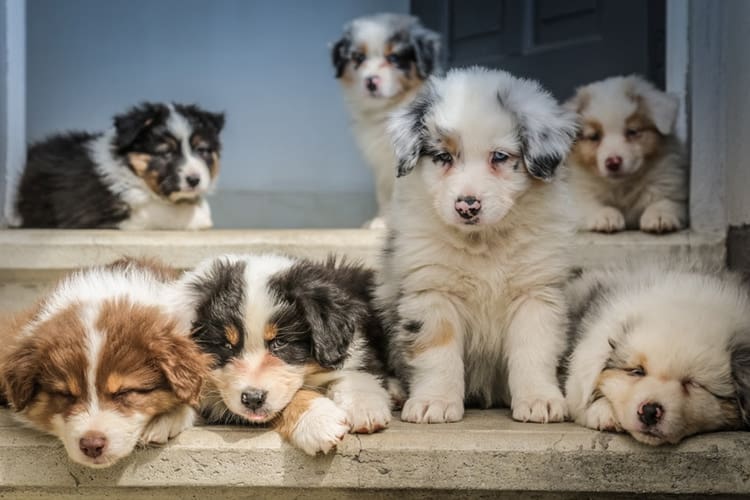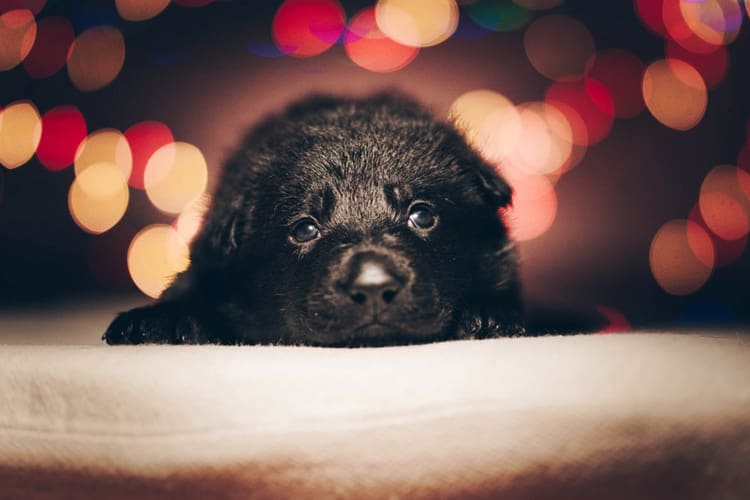Who doesn’t love newborn puppies? We’re cute, cuddly, and offer unconditional love. We can also be a lot of work. Puppies take a while to become self-sufficient. One our biggest concerns is fleas. We’re the perfect host.We snuggle with each other and our mother,our bodies produce moisture -it’s not surprising that puppies as young as a week old can be infested with fleas. If you have a new litter at the house, removingthe infestation can feel like a daunting task.There’s no doubt that it’s a difficult task, but with a bit of patience, it can be done.
The Rundown on Fleas
We’re all familiar with fleas. I’ve personally never had them, but my mom and dad give me preventative medicine. However, they’re an unfortunate fact of a dog’s life. Most of us are aware that fleas are a parasitic bug that feeds on our blood. But fleas are much more than a disgusting inconvenience, especially when it comes to newborn puppies. Because a puppy is a perfect host, they can quickly become overinfested. Since our bodies arent equipped to handle this infestation, fleas can become dangerous, leading to anemia, worms, and, in some cases, death. To treat them properly, we need a better understanding of the problem.

- A Flea’s Life Cycle– A flea’s life cycle begins with the egg and ends as an adult. A typical cycle will take 21 days from the egg to an adult,but that can change depending on the environment.A warm, humid area will speed the process up, while a cool, dry environment will slow it down.
- A Single Female Flea Will Lay Many Eggs–It’s estimated that one female flea can lay between 20 and 50 eggs, which is enough for a major infestation. Now, consider how many female fleas might be living on your dog at one time, and it’s easy to see how they spread so quickly and the problem becomes serious before you’re aware.
- Fleas Will Live a Long Time Without Eating– It can be a common misconception that a flea will die if it doesn’t feed. However, adult fleas can live up to two weeks without consuming any blood, meaning they can comfortably hide until the right host comes along. Apupa, though, can stay in its cocoon for up to a year while waiting for the right conditions.
- Puppies That Spend Most of Their Time Inside Can Still Get Fleas– Another common misconception is that dogs that spend most of their time inside won’t get fleas. But fleas are very easy to transport. They can be brought into the house in a variety of ways, including clothing. Although it might be less likely for a puppy that doesn’t go outside to get fleas, it’s still possible.
- A Puppy Can be Allergic to a Flea Bite– The No. 1 sign of fleas is if a puppy starts scratching. While this is normal behavior, excessive scratching could be an indication of an allergic reaction to the bite itself. This can lead to open soars and infection.
- Fleas Can Make a Puppy Very Sick– This is especially the case in very young puppies that have an underdeveloped immune system. Fleas can quickly infest a young pup and cause anemia, which can kill the host.
Fleas also carry tapeworm, which is transmitted when your puppy swallows fleas while they’re grooming themselves. Puppies also have trouble fighting off tapeworm on their own.
You Can’t Use Typical Flea Treatments on Young Puppies

Before we explain how to rid your puppy of fleas, it’s important to know that a regular flea treatment, including flea shampoo, can’t be used for puppies. A young pup’s skin very sensitive and their immune system is underdeveloped, meaning they’re very susceptible to serious side effects associated with the chemicals in flea treatments. Puppies can develop skin conditions and experience anything from vomiting and breathing problems to life-threatening neurological damage, paralysis, and seizures. Flea treatments shouldn’t be used on any puppy under 10 weeks of age.
How to Get Rid of Fleas on a Newborn Puppy
Flea treatments for puppies need to be natural. Although this may seem like a tedious process, it’s important for the health and well-being of your pup.
1. Eliminate Fleas on the Mother
There’s a good chance young puppies will pick up fleas from their mother. You’ll experience a never-ending cycle if you only try to eliminate a puppy’s fleas. Just like with people, a mother dog can pass things onto their puppy through their milk. As mentioned before, it’s important not to use flea treatments on newborn puppies, but you also must know that some chemicals could be passed from mother to pup. Thankfully, there are flea treatments that are safe for both a nursing mother and their puppies. Seek advice from a vet to ensure the puppies aren’t at risk of exposure to harmful chemicals.
If you prefer not to take the risk, you can eliminate fleas on the mother by giving them a thorough bath and combing them with a flea comb. Keep in mind that you’ll probably need to use the comb multiple times to eliminate the fleas.
2. Treat the Puppies
A bath is the only one effective way to rid a young puppy of fleas without using harmful chemicals. If you’re treating a litter, it’s important to bathe the puppies individually and keep the already-washed ones separate from the unbathed, as fleas are incredible jumpers. Here’s a step-by-step guide to washing your puppy:
- Prepare a sink or basin with warm water. Remember that the puppy’s skin is still very sensitive, so don’t make it too hot.
- Place the puppy in the warm water. Support their head, hold it above the water, and pour it over the pup until their coat is wet. Once the coat is completely wet, remove the puppy and dry them with a towel.
- After drying them, use a fine-toothed flea comb on their still-damp fur. The right comb will remove both the eggs of an adult flea as well as the fleas themselves. Start at the neck and part the fur, combing a small section of it at a time and removing any fleas you see. After each comb through, dip the comb in boiling water and remove any fleas that might be stuck to it. The boiling water will kill the fleas and any flea eggs that have come off the puppy, ensuring that you’re not cross-contaminating. This process continues head to toe and should be done several times with each puppy to ensure that all the fleas are gone. A single remaining flea can lead to another infestation.
3. Get Rid of the Fleas in the House
If your puppy has fleas, your home will, too. They’ll be in the puppy’s bedding, in the carpet, and probably in your bed. If you don’t get rid of them in the house, it’ll only be a matter of time until they find their host and lead to further flea infestation. Here’s how you can prevent that from happening:
- Vacuum the entire house, moreso the high-traffic areas that your puppy uses. Use a vacuum with a bag to avoid having contact with the fleas you pick up. If it’s not possible, be very careful with the vacuum’s contents when emptying to prevent spreading the fleas.
- Once vacuumed, use a steam cleaner to clean all non-washable material, like the carpet and upholstery. The combination of soap and heat is aflea’s enemy.
- Wash all of the bedding and curtains, including the puppy’s bed and your own.Use hot water before drying them on the highest heat possible. The extreme heat will kill any fleas and their eggs.
- Use an insecticide aerosol spray to cover the areas that may not have otherwise been accessible. Be very careful with insecticide as it can be harmful to you and the animals in the house. Keep everyone away from the area that’s being sprayed until the insecticide is completely dry.
While this process can be tedious, it’s the best way to rid your young puppies of their nasty pests without endangering them, leaving you with a happy and healthy pup.